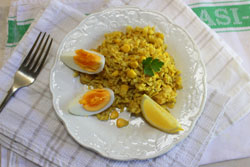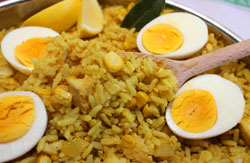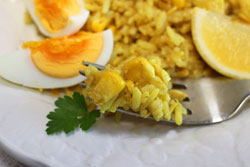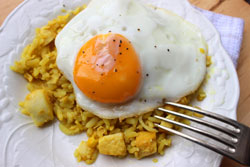
I’m not sure how classic sweet corn is in kedgeree, famously served at breakfast in aristocratic country houses under a silver domed ‘chafing dish’. Somehow, the bright yellow colour and those little pockets of sweetness that pop in your mouth just seem to make an already lovely combination of flavours even more fabulous.
As you probably know already, kedgeree became popular in Victorian times, during the British Raj. It was brought home by colonials, who had enjoyed it in India, and it became a blend of Indian and Anglo cuisine, basically rice, smoked fish and cayenne pepper or curry seasoning adapted from a dish that originally included lentils as well.
Once I was making kedgeree and realised we’d run out of sweetcorn. The thought of eating it without was so miserable I found myself combing a bag of mixed frozen vegetables for all the kernels!
Use drained tinned corn, fresh or frozen: if using fresh see below for removing the kernels from the cob below.

Tip
Use cooked rice if you prefer but make sure it still has a little bite to it before adding to the pan.
Serves 6-8
- 1 onion, finely diced
- 2-3 tablespoons oil
- 1 dessert spoon Madras curry paste (or to taste)
- 1 level teaspoon turmeric
- 400g long grain rice
- 800ml-1 litre cold water
- 400g smoked haddock or cod fillet, skinned and cut into bite-size pieces
- 150g sweetcorn kernels
- 1 bay leaf
Cook the onion slowly until transparent but barely coloured. Stir in the curry paste and turmeric. Continue to cook for 2-3 minutes. Add the rice, stirring it through until each grain is coated with oil.

Pour in around 800ml of the water; cover and simmer for 15 minutes.
Stir in the fish and corn, add the bay leaf. Top up with the remaining water if necessary.
Partially cover and continue to simmer for around 25 minutes or until the rice is cooked and the liquid has been absorbed.
Serving Suggestions
Stir a little cream or butter in at the end for a touch of luxury plus a squeeze of lemon: serve with hard-boiled or fried eggs with mango chutney or tomato ketchup respectively.

How to Husk Fresh Corn
You will need a sharp knife.
Cut the cobs from the leafy husks and remove the silky threads.
Slice the ends flat.
Stand the cobs upright on a non-slip surface.
For extra safety remove the kernels from the lower half first: running a sharp knife down the sides and turning the cob until all the kernels are detached.
Then turn the cob upside down so the top is now the lower half and repeat.
Alternatively, cut cobs in half for husking.